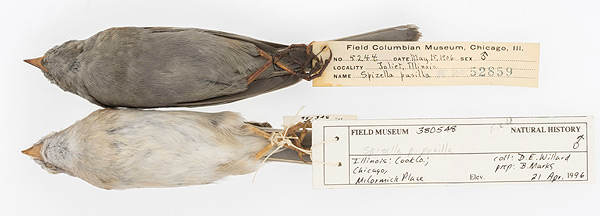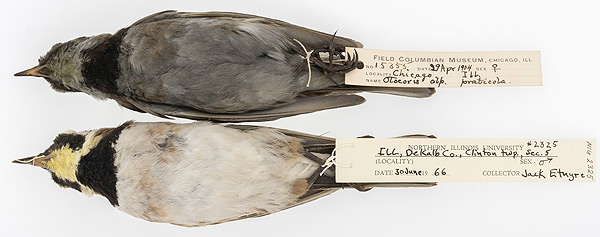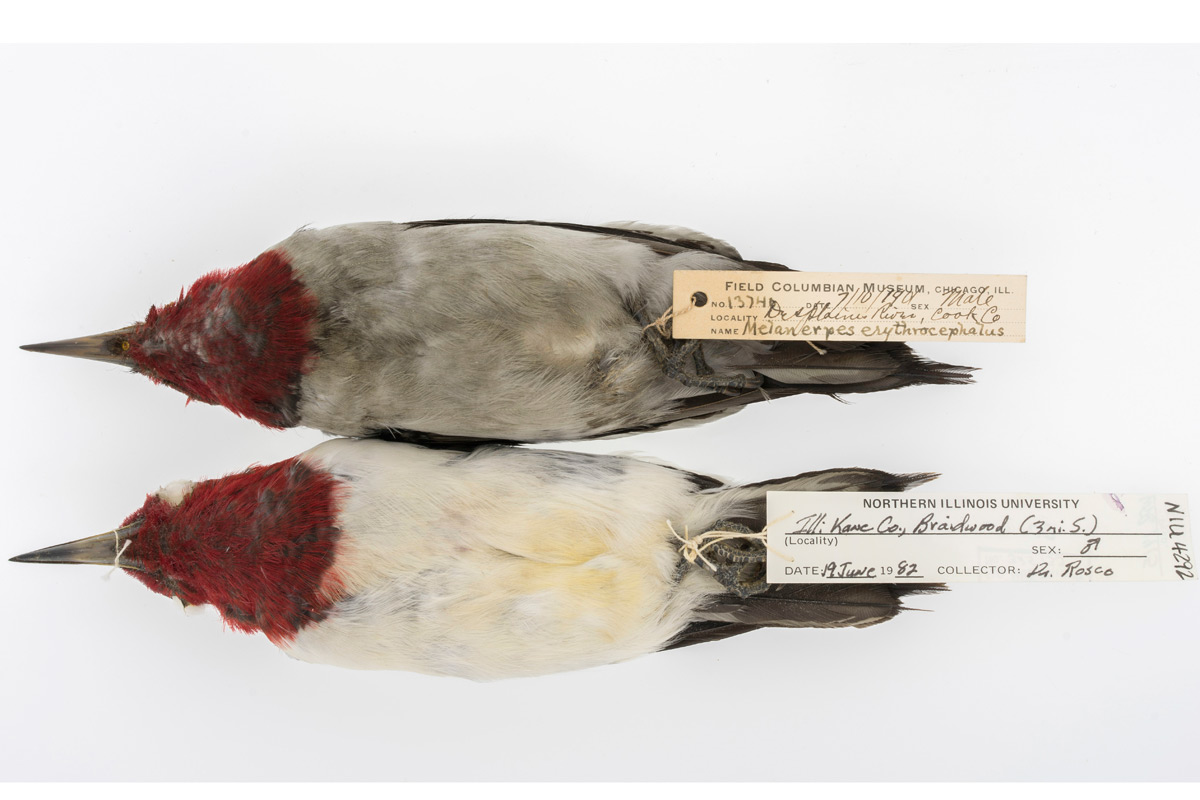Below are two birds, both Spizella pusilla, better known as the field sparrow. The one on top was collected in 1906 in Joliet, the one on the bottom at McCormick Place 90 years later; both are in the collection of the Field Museum. Spot the difference; it's not hard.

Here's another one. These are horned larks, also housed at the Field Museum, from 1904 and 1966.

The dark gray coloration is soot. Birds in dense, manufacturing-intensive urban areas like the upper Midwest used to look like this, as two researchers from the University of Chicago—Shane DuBay from the Committee on Evolutionary Biology and Carl Fuldner of the Department of Art History (now at Yale)—found.
"We were looking at drawers of bird specimens at the Field Museum. It was me, Carl, and some of the curatorial staff at the museum, and just looking at a tray of specimens, we could see the variation in sootiness," DuBay says. "We could visually place these birds in time based on their coloration. Carl would be like 'that bird's really dark, I bet it's from the first few decades of the 1900s.' We'd look at the tag, and it was. It was from Joliet, near the second-largest steel refinery during that period."
Soon they realized that they could go farther than just eyeballing them.
"It became apparent that if we used a rigorous, formal method to characterize relative sootiness of individuals, we would then have an amazing resource and data set to be able to track changes in this environmental pollutant through time," DuBay says.
They'd come across an inadvertent sample of pollution, specifically atmospheric black carbon, stretching across more than a century. The sample dates back to 1880, more than seventy years before consistent records were kept. Using a camera, they were able to generate estimates of air pollution from the years and localities that bird specimens were taken, one that builds on prior estimates of air pollution and tells a story about how different policies combined to reduce it over the first half of the 20th century, as they detail in a new PNAS paper.
DuBay and Fuldner began by taking 1,347 specimens from five species of birds, all found in what they call the "U.S. manufacturing belt"—Pennsylvania, Ohio, Indiana, Michigan, Illinois, and Wisconsin—stored in the collections of natural history museums. They photographed them, and using raw data from the camera sensor to measure their reflectance—because black carbon absorbs light, the reflectance indicated how much atmospheric black carbon had been picked up by the birds. And because they molt each year, the amount of soot on their feathers was representative of a clear range of time.
When they began to plot their data, patterns began to emerge.
First, the data revealed differences with prior records of historical black-carbon pollution. There are two major ones: Greenland ice cores and the SPEW (Speciated Pollutant Emissions Wizard) database. The former measures only pollution that made it to Greenland, without the localization of the bird-based approach; the latter is extrapolated from records of coal consumption, which makes it harder to account for changes in emissions from changing coal-burning technology.
The data generated by the sooty birds found higher concentrations of black carbon from 1880 to 1900 than either the ice-core or SPEW data indicate, with possible consequences for how we understand climate change.
"In the past few decades, mainly from 2000 on, there have been a number of incredibly convincing studies and arguments that black carbon is one of the major climate forcing agents that we have emitted into our atmosphere," DuBay says. "One of the big implications of our study is that, if we can get a more accurate picture of historical emissions, of historical atmospheric conditions, it will allow us to better understand the relative contributions of climate-forcing agents like black carbon to past climates."
DuBay and Fuldner also found that the data correlated with attempts by policymakers to combat air pollution, from the 1880s through the middle of the 20th century—in particular, policies that began at the city level long before the federal government passed major antipollution legislation in the 1950s and 1960s. Chicago was a pioneer; though it didn't necessarily have the first coal-burning ordinance, it was the first that seems to have been enforced, and from there other cities began to regulate coal fuel. Nonetheless, it was a mere first step.
"Basically those early ordinances were largely symbolic. They were based on nuisance law, which made them difficult to litigate," Fuldner says. "They typically included exemptions for domestic chimneys, for example. We know that domestic coal burning, the vast majority of homes, used to be heated with coal-burning stoves, which accounts for over half of the estimated total emissions from the early part of the century. And those were exempted from the early laws."
Their data suggests that, nonetheless, the laws at least tempered the rise of black-carbon pollution, but it would take a combination of approaches to actually reduce it. Here cities led the way, in ways that have implications for attempts to reduce different pollutants today.
"You do start to see a gradual change that happens after the first decade of the 20th century. That happens with a shift in policy approach that we found that was a shift from basically litigating and fining violators, typically industrial violators—so a smoke inspector using these crude visual devices to estimate the amount of black smoke that was being emitted from the chimneys and possibly fining them, but not necessarily addressing the root cause—to a deliberate attempt to educate these violators in terms of the benefits of using better technology, or using the same burning technologies that they were already using, but using them in a more efficient way," Fuldner says.
Prominent among those cities was St. Louis, which went beyond educating coal users to making it easier for them to switch to less dirty fuel, with profound and immediate effects for its residents.
"One of the great pieces of municipal law that came out of St. Louis was that if you were going to buy soft coal, you had to show that you could burn it efficiently using a mechanical stoker," DuBay says. "With more efficiency, you get less soot being emitted into the atmosphere. If you did not have a mechanical stoker, then you had to buy harder coals that themselves burn cleaner. And part of that is that the city, St. Louis, bought up a lot of hard coal to provide in an affordable way to the citizens."
From 1940 to 1941, the total hours of atmospheric soot fell 84 percent in St. Louis.
Cities also began to transition to petroleum and natural gas, and to move away from smaller, scattered-site coal-driven steam boilers to massive coal-fired power plants. Coal consumption actually began to climb from the mid-1950s up until recent years, but atmospheric black carbon continued to decline as mitigation efforts improved.
Alternative fuel technologies came with their own problems, pollutants that don't blot out the sun or coat the feathers of birds, but the lessons learned from the process of reducing black-carbon pollution are significant for those technologies going forward. And in some ways they mirror more recent efforts to combat urban pollution, like those of Hazel Johnson in Altgeld Gardens, Kimberly Williams in Little Village, and Marian Barnes and Olga Bautista on the Southeast Side.
"What we know, when we dig into the rich environmental history of the cities in the manufacturing belt, Chicago, Pittsburgh, Detroit, and others," Fuldner says, "is that the initial push against urban smoke, against urban air pollution, started at the city level, and it started at the citizen level, with citizens' groups, reform groups. And they were often led by women—women's groups that were combating the smoke issue."



